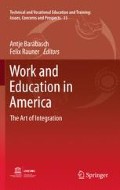Abstract
The United States system of vocational/career and technical education is broad and diverse, and serves multiple educational constituents. Vocational/career and technical education can be found as early as grade seven in the US educational system, with most of the curriculum located in high schools, career centers, postsecondary institutions, correctional facilities, and adult education programs. Federal support first dates back to 1917, with the passage of the Smith-Hughes Act, which allocated funds for vocational/career and technical education. Historically, vocational/career and technical education has been offered within six broad areas of study: Agricultural Education, Business Education, Family and Consumer Sciences Education, Health Occupations Education, Marketing Education, and Trade and Industrial Education. New curricular approaches have attempted to meet the changing needs of the global marketplace and technological innovation through the integration of vocational/career and technical education with academic disciplines, articulation with postsecondary institutions, and entry into broader career fields.
Access this chapter
Tax calculation will be finalised at checkout
Purchases are for personal use only
References
Backes, C. E. (2000). Creating an advisory committee: Improving vocational programs with community support. Tech Directions, 60(1), 24–27.
Bottoms, G., Han, L., & Murray, R. (2008). High school experiences that influence reading proficiency: What states and schools can do. Atlanta, GA: Southern Regional Education Board.
Bottoms, G., Han, L., & Presson, A. (2006). Urban students achieve when high schools implement proven practices. Atlanta, GA: Southern Regional Education Board.
Bottoms, G., & Uhn, J. (2007). Project Lead The Way ® works: A new type of career and technical program. Atlanta, GA: Southern Regional Education Board.
Bottoms, G., & Uhn, J. (2008). Transitioning to college and careers from a High Schools That Work high school: A follow-up study of 2006 high school graduates. Atlanta, GA: Southern Regional Education Board.
Calhoun, C., & Finch, A. (1982). Vocational education: Concepts and operations. Belmont, CA: Wadsworth.
Cohen, A., & Brawer, F. (2008). The American Community College. San Francisco: Jossey-Bass.
Draeger, M. (2006). How students benefit from high-tech, high-wage career pathways. New Directions for Community Colleges, 135, 81–89
Gordon, H. (2008). The history and growth of vocational education in America. Long Grove, IL: Waveland.
International Technology Education Association. (2003). What is technology education? Retrieved January 2, 2009, from http://www.iteaconnect.org/AboutITEA/about.htm
Kerka, S. (2002). Effective advisory committees. Columbus, OH: National Dissemination Center for Career and Technical Education.
Levesque, K., Laird, J., Hensley, E., Choy, S. P., Cataldi, E. F., & Hudson, L. (2008). Career and technical education in the United States: 1990 to 2005 (NCES 2008–035). Washington, DC: National Center for Education Statistics, Institute of Education Sciences, U.S. Department of Education.
Lewis, S., Mears, D., Dubin, G., & Travis, J. (2002). The practice and promise of prison programming. Washington, DC: Urban Institute.
Marketing Education Association. (2009). About MEA. Retrieved January 2, 2009, from http://www.nationalmea.org/Abtmea.html
Miller, D., & Gray, K. (2002). Tech prep persistence in comprehensive high schools: An exploratory study. Journal of Industrial Teacher Education, 39(4), 26–35.
MRDC. (2009). Career academies. Retrieved March 2, 2009, from http://www.mdrc.org/project_29_1.html
National Council for Agricultural Education. (2009). About agricultural education. Retrieved January 2, 2009, from http://www.teamaged.org/aged.htm
Project Lead the Way. (2008). Our mission, goals and core values. Retrieved November 2, 2008, from http://www.pltw.org/about/mission-goals-core-values.html
Rogers, G. (2006). The effectiveness of Project Lead the Way curricula in developing pre-engineering competencies as perceived by Indiana teachers. Journal of Technology Education, 18(1), 66–78.
Ruhland, S. (2003). Evaluating tech prep education programs: Implications for reporting program and student outcomes. Journal of Vocational Education Research, 28(1), 35–57.
Scott, J., & Sarkees-Wircenski, M. (2008). Overview of career and technical education. Homewood, IL: American Technical Publishers.
Smith, C. L., Payne, E. G., & Thornton, G. M. (2001). Standards and guidelines for work-based learning programs in Georgia. Atlanta, GA: Georgia Department of Education.
Southern Regional Education Board. (2007). High Schools That Work: An enhanced design to get all students to standards. Retrieved December 28, 2008, from http://www.sreb.org/programs/hstw/publications/2005Pubs/05V07_enhanced_design.pdf
Stone, J., & Aliaga, O. (2005). Career & technical education and school-to-work at the end of the 20th century: Participation and outcomes. Career and Technical Education Research, 30(2), 125–144.
United States Department of Education. (2004). National assessment of vocational education. Washington, DC: Author.
United States Department of Education. (2007). Digest of education statistics. Washington, DC: Institute of Education Sciences.
United States Department of Education. (2008). Tech Prep Education. Retrieved December 28, 2008, from http://www.ed.gov/about/offices/list/ovae/pi/cte/tpreptopic2.html
United States Department of Labor. (2009). Apprenticeship. Retrieved February 25, 2009, from http://www.doleta.gov/jobseekers/apprent.cfm
Wolf Harlow, C. (2003). Education and correctional populations. Washington, DC: U.S. Department of Justice, Office of Justice Programs, Bureau of Justice Statistics. Retrieved March 11, 2009, from http://www.ojp.usdoj.gov/bjs/pub/pdf/ecp.pdf
Young, J. W., & Cline, F. (2008). Are scores on the HSTW assessment related to students’ self-reported educational experiences?. Princeton, NJ: Educational Testing Service.
Zirkle, C., & Connors, J. (2003). The contribution of career and technical student organizations (CTSO) to the development and assessment of workplace skills and knowledge: A literature review. Workforce Education Forum, 30(2), 15–26.
Organizational and Internet Resources
Professional Organizations
American Association of Family and Consumer Sciences (AAFCS)
Association for Career and Technical Education
International Technology Education Association
Marketing Education Association
National Council for Agricultural Education
Vocational/Career and Technical Student Organizations
Business Professionals of America
http://www.bpa.org/Distributive Education Clubs of America
Family, Career and Community Leaders of America, Inc.
FFA
Future Business Leaders of America – Phi Beta Lambda
Health Occupations Students of America
National Young Farmer Educational Association
National Postsecondary Agricultural Student Organization
SkillsUSA-VICA
Technology Student Association
Author information
Authors and Affiliations
Corresponding author
Editor information
Editors and Affiliations
Rights and permissions
Copyright information
© 2012 Springer Science+Business Media B.V.
About this chapter
Cite this chapter
Zirkle, C. (2012). The Multitiered CTE/VET System in the United States—From High School to Two-Year Colleges. In: Barabasch, A., Rauner, F. (eds) Work and Education in America. Technical and Vocational Education and Training: Issues, Concerns and Prospects, vol 15. Springer, Dordrecht. https://doi.org/10.1007/978-94-007-2272-9_3
Download citation
DOI: https://doi.org/10.1007/978-94-007-2272-9_3
Published:
Publisher Name: Springer, Dordrecht
Print ISBN: 978-94-007-2271-2
Online ISBN: 978-94-007-2272-9
eBook Packages: Humanities, Social Sciences and LawEducation (R0)

